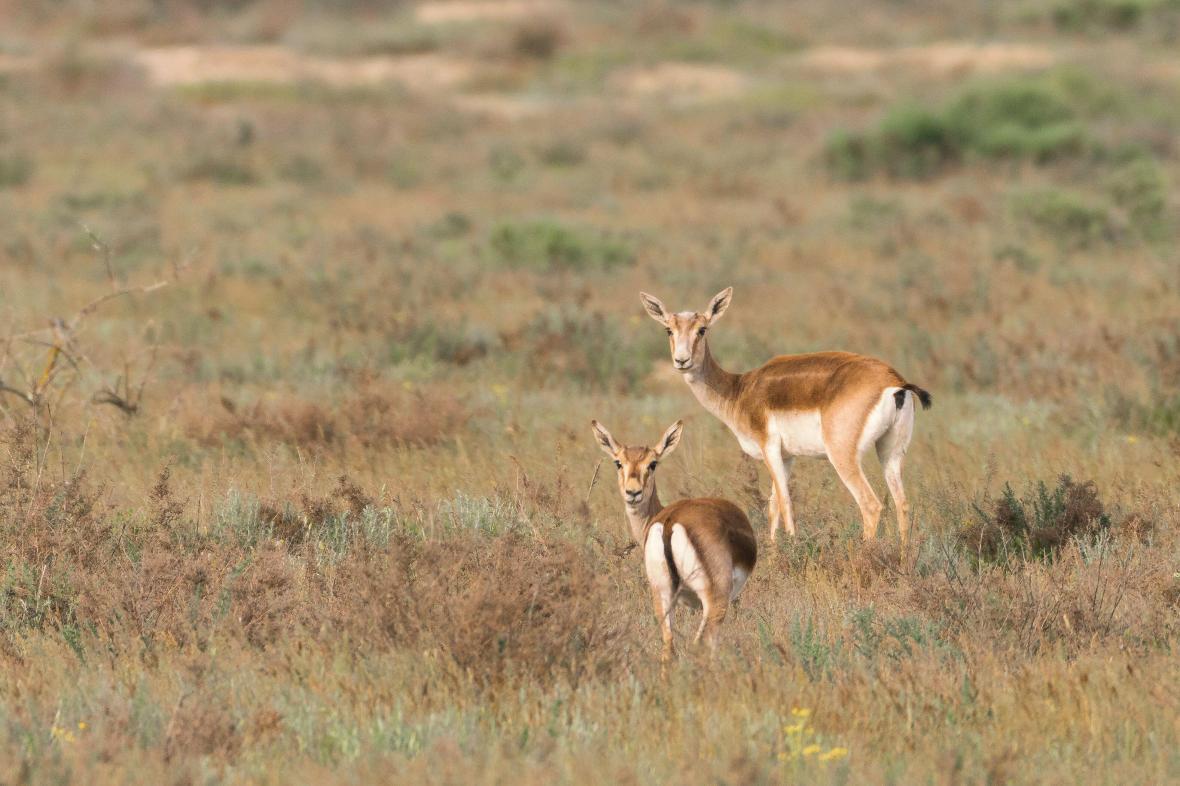Mine-dodging gazelles reclaim abandoned battlefield Article by The Times
The UK-based The Times has published an article, saying that the Karabakh region "languished as a grey zone for three decades until environmentalists found a use for the perilous area". Caliber.Az reprints the article.
A line of elegant gazelles leap through the low undergrowth of the grassy plain, against the backdrop of an extinct volcano. Overhead, birds swoop and soar in formation. In the warm November sunshine, this could be a nature reserve in Africa, not Azerbaijan — if it weren’t for the line of working oil shafts on the horizon.
The Shirvan National Park sits directly to the southwest of Baku, Azerbaijan’s gilded, petrochemical-rich capital, and is one of the most important wetlands in the region. Migratory birds including flamingos stop off at its lakes, and it is also the home of a project that is repopulating the country with Eurasian goitered gazelles, a species once endemic to the area that was decimated by development and hunting.
At the turn of the 20th century, there were about 600,000 gazelles living in the Southern Caucasus. They were a sight so common that gazelle meat was sold in the markets of Tbilisi, the Georgian capital. But during the Soviet era, much of their grassland habitat was cultivated for wheat and grapevines — the region produced some of the best-known wines in the empire. In the places where the gazelles remained, they were hunted to near extinction, and by 1960 only 200 were left. In 1961 Shirvan was put under official protection and environmentalists began working to boost the number of gazelles.
“This gazelle has a big influence on our country’s folklore, and it is still respected,” said Elshad Askerov, the WWF’s director in Azerbaijan. “The people living in the countryside want them to come back.”

Since the 1990s there has been an additional problem, however.
A fifth of Azerbaijan’s territory, in a mountainous area called Nagorno-Karabakh, was seized by Armenia in a war sparked by the break-up of the Soviet Union. Much of it was left abandoned and heavily mined for the next three decades and the area languished as an unrecognised grey zone. In the autumn of 2020, Azerbaijan launched an offensive to take back the area. Since then, it has embarked on intensive demining and development work to rejuvenate and repopulate the seven districts of Karabakh that were once home to about 700,000 ethnic Azeris (in September Baku launched a second offensive and also seized the Armenian-inhabited parts of the region).
The environmentalists have spotted an opportunity. Although larger animals such as bears and horses are frequently maimed by landmines, gazelles are so fleet-footed that they do not set them off, and the abandonment of the area has restored some of the habitats that were lost — although Baku’s warp-speed redevelopment of Karabakh is cutting into them again. Last year the project released its first group of 33 gazelles that were born and raised in Shirvan into the area.
Two were tagged with GPS collars so that Askerov and his team could track them — but then another war got in the way. After Russia invaded Ukraine the Kremlin started jamming GPS systems across the region to foil attacks. The satellite system the collars were using slowed down, and then stopped working altogether and the scientists lost track of the gazelles. When they release their next group, they will be fitted with different devices, Askerov said, but through visual tracking, they know that the animals are settling into their new home. The latest count showed that there were almost 7,000 gazelles living across Azerbaijan.
Environmentalists have also seen some success in reintroducing leopards, which were once so common that they were viewed as pests. They were thought to have gone extinct in the 1970s, but in 2002 a survey project found that there were some traces of them in the mountains. Five years later the team put up cameras and captured footage proving the leopards were still there — “the biggest success of my life”, Askerov said. To date, about 30 have been observed, and they have begun breeding on Azerbaijani soil.
The Caucasian tiger once prowled here and across central Asia too, but it has long been extinct. Kazakhstan, which has started a project to introduce the Siberian tiger in its place, offered to give a pair to the park, but the scientists refused.
“Tigers need a huge area,” Askerov laughed. “Kazakhstan has the space for them. We don’t.”








